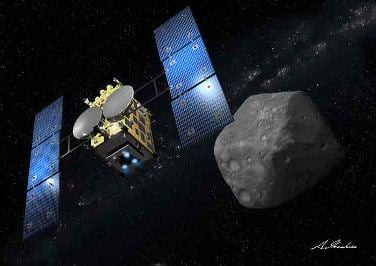Mission type Asteroid sample return COSPAR ID 2014-076A Website Hayabusa 2 on jaxa.jp | Operator JAXA SATCAT no. 40319 Manufacturer NEC | |
 | ||
Hayabusa2 is an asteroid sample return mission operated by the Japanese space agency, JAXA. It follows on from Hayabusa and addresses weak points learned from that mission.
Contents
Mission overview
Initially, launch was planned for 30 November 2014 (13:23 local time), but was delayed to 3 December 2014 04:22 UTC (4 December 2014 13:22:04 local time).
The target is asteroid 162173 Ryugu (formerly designated 1999 JU3). Hayabusa 2 is expected to arrive at the target in July 2018, survey the asteroid for a year and a half, depart in December 2019, and return to Earth in December 2020.
The spacecraft features ion engines, upgraded guidance and navigation technology, antennas and attitude control systems. Operations at the asteroid will be similar to those of the previous Hayabusa, but with an explosive device to dig the asteroid surface for fresh sample material.
Funding
Hayabusa2 was approved by the Space Activities Commission, a board governing funding for the Japanese space program, during 2006. In July 2009, at the 27th ISTS (International Symposium on Space Technology and Science) conference in Japan, Makoto Yoshikawa of JAXA presented a proposal entitled "Hayabusa Follow-on Asteroid Sample Return Missions." In August 2010, JAXA obtained approval from the Japanese government to begin development of Hayabusa 2. The estimated cost of the project is 16.4 billion yen.
NEC Corp., the builder of the Hayabusa probe, began the systems design of the 590 kg (1,300-pound) spacecraft, its Ka-band communications system and an intermediate infrared camera.
Instruments
The German Aerospace Center built a small lander called MASCOT (Mobile Asteroid Surface Scout) for the mission in a cooperation with the French space agency CNES. The MASCOT carries an infrared spectrometer, a magnetometer, a radiometer and a camera, and is capable of lifting off of the asteroid to reposition itself for further measurements.
The Small Carry-on Impactor (SCI) is a small drop-off explosively formed penetrator, consisting of a 2.5 kilogram (5.5 lb) copper projectile and a 4.5 kilogram (10 lb) shaped charge. It will be dropped off Hayabusa2; the low gravity leaves the spacecraft enough time to maneuver to the opposite side of the asteroid. A second instrument will then be deployed, the deployable camera (DCAM3). This camera will observe the explosion of the Small Carry-on Impactor instrument. The copper penetrator will strike the asteroid with a velocity of 2 km/s. The crater formed by the impact will be the site of further observations by the spacecraft. The shaped charge will consist of 4.5 kg of plasticized HMX with a 2.5 kg copper liner.
